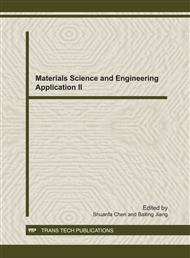p.1
p.7
p.11
p.18
p.24
p.29
p.34
p.38
p.42
Research on Carbon Dioxide Corrosion of Cement Stones of Oil Well Casings under High Temperature and High Pressure
Abstract:
The effect of CO2 on seal capacity of cement mantle causes casing corrosion and reduces the life of oil well. The corrosion proof of cement system is studied to improve the integrity and seal properties of the cement stone under acidic medium. The CO2 corrosion test of 5 blocks cement under high temperature and high pressure was conducted. Compressive strength, permeability and corrosion depth were measured and morphology after corrosion was observed by scanning electron microscope. A density cement slurry formulations was selected by analyzing the experimental data. It not only has excellent corrosion resistance, but also has properties of anti-gas breakthrough, reduction of free water and stability. It can meet cementing requirement of different well depth conditions.
Info:
Periodical:
Pages:
24-28
Citation:
Online since:
December 2011
Authors:
Price:
Сopyright:
© 2012 Trans Tech Publications Ltd. All Rights Reserved
Share:
Citation:


